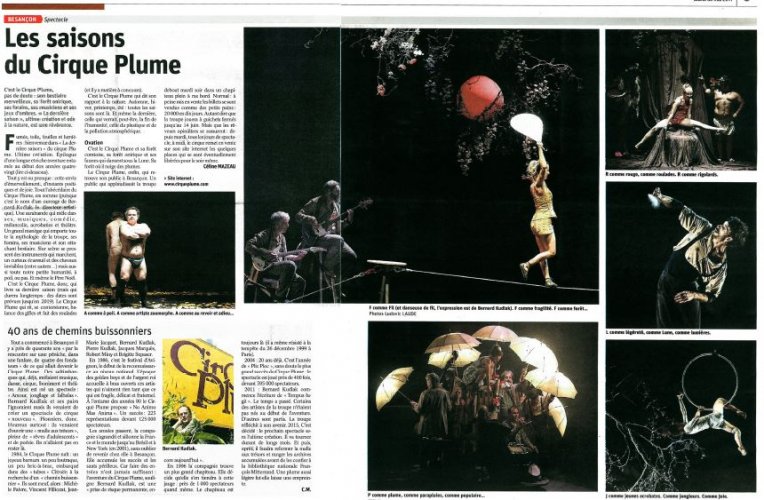L’Est Républicain30 May 2017
The Seasons of Cirque Plume
This is Cirque Plume, without a doubt: its magnificent bestiary, its dreamlike forest, its carnivalesque invitations, its musicians, and its interplay of shadows and light. “La dernière saison,” a last production and an ode to nature, is also a final bow.
Smoke, canvas, tree leaves, and lights: welcome to “La dernière saison” – “The Last Season” – of Cirque Plume. Its final creation. An epilogue to a long and rich adventure started in the early 1980’s (see below).
It’s all there, or just about anyway: that desire for wonder, moments of poetry, and joy. All in all, it’s a whole Abécédaire, or primer, on Cirque Plume (bringing to mind the work Abécédaire by the company’s artistic director, Bernard Kudlak). A sarabande that blends dance, music, comedy, melancholy, acrobatics, and theatre. A great fair ride that carries all the mythology of the troupe: its carnivalesque performers, its musicians, and its enchanting bestiary. Instruments that walk, a curious squirrel, and invisible horses (among others) all throng onstage, along with small bits of humanity, unclothed… or not. Even Santa Claus makes an appearance.
This is Cirque Plume, performing its last season (although it’s a season that will last a while: dates are scheduled through 2019). It’s a circus that laughs, that ties itself in a contortion of knots, that performs slapstick and somersaults (and there is room for competition!).
This is the Cirque Plume that speaks of its relationship to nature. Fall, winter, spring, summer: all the seasons are there. Even a final season, one that may witness the end of humanity, a season of plastic and pollution.
Ovation
This is Cirque Plume and its Franche-Comté forests, its dreamlike forest and its wildlife dancing under the moon. Its own forest, where feathers fall like snow.
The Cirque Plume has found its audience once again in Besançon. An audience who stood cheering for the troupe Tuesday evening in a big top that was filled to the brim. Normal: the tickets had barely gone on sale before they were sold comme des petits pains: 20,000 in ten days. The troupe will play to sold out houses through June 14. But the determined dreamers can rest assured: As of last Tuesday, on every show day at noon, the circus puts a few tickets on sale on their website for that same evening.
40 Years Off the Beaten Path
It all started in Besançon nearly forty years ago “on a small boat, amidst much fanfare, during a get-together between the four founders” — the founders of what would become the Cirque Plume. They were street artists and acrobats who were already mixing music, dance, circus, jest, and theatre. Hence the show “Amour, jonglage et falbalas” was born.
Bernard Kudlak and his peers didn’t know it, but they had just created a “nouveau cirque” performance. They were pioneers. Above all, they were happy: They had just opened a “treasure chest” full of “adolescent dreams” and poetry. And they weren’t going to stop there.
In 1984, the Cirque Plume was born: a merry, slightly wacky, patch-worked together kind of display, boarded into a Citroën tube in search of long-winding roads. There were nine of them then: Michèle Faivre, Vincent Fillioza, Jean-Marie Jacquet, Bernard Kudlak, Pierre Kudlak, Jacques Marquès, Robert Miny, and Brigitte Sepaser.
In 1986, it was the Avignon Festival that brought the beginning of national recognition. The era of golden boys and of “cash as king” welcomed with opened arms this band of artists, performers who loved nothing more than what was fragile, delicate, and fraternal.
In the early 1990’s Cirque Plume created “No Animo Mas Anima”. A success: 223 shows were performed before 125,000 spectators.
The years went by. The company grew, and made its way across France, across the world, and all the way to Brazil and to New York City (in 2001), never forgetting to return home to Besançon. As the troupe became more successful, it continued to take leaps, many of them perilous. For making entrances is never enough: The adventure of Cirque Plume, notes Bernard Kudlak, is a “permanent risk, even today.”
In 1996 the company found a bigger big top. The troupe decided to go with this new scale: a house of nearly 1,000 seats. The tent is still in use today (it even weathered the storm of December 26, 1999 in Paris).
2004: 20 years already. This was the year of “Plic Ploc.” Undoubtedly Cirque Plume’s most successful show to date, the show was performed over 400 times, reaching 395,000 spectators.
2011: Bernard Kudlak began writing “Tempus fugit.” Time passed. Some of the artists in the troupe hadn’t even been born when the adventure of the troupe had begun.
Others left. The troupe reflected on its future. It was decided, in 2015: The next show would be the troupe’s final creation. It would tour for many long months. And then, the treasure trove would be closed: the archives that had been accumulated would be put away and entrusted to the François Mitterrand National Library. A feather — a plume — that was just light enough to leave a mark.
Céline Mazeau








